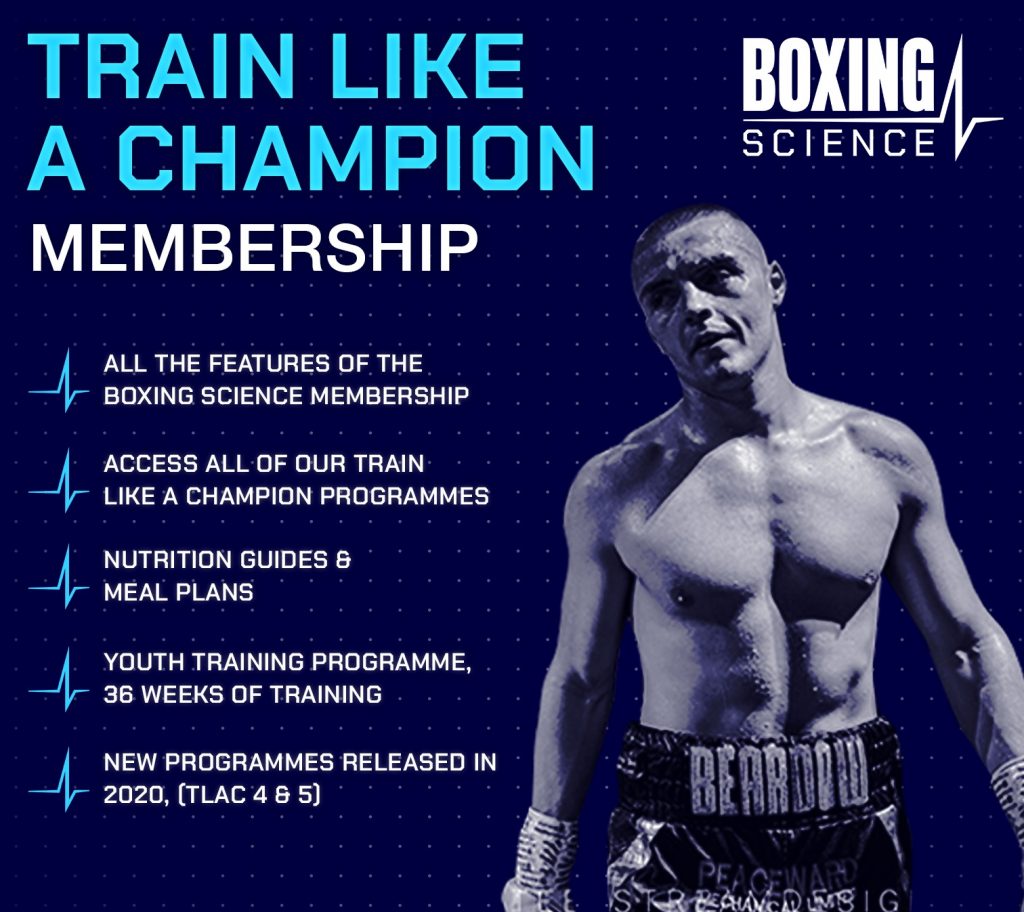Boxing Fitness: High-Intensity Conditioning
Physical conditioning has always been a huge priority for boxers. Whether it’s Muhammad Ali’s long road runs, Mike Tysons skipping workouts or Manny Pacqiaou’s Track sessions, the greats have always put in the hard graft in search for supreme fitness.
In fact, ask any boxer and they’ll tell you how important physical fitness is for successful performance. It’s important to be able to work at high-intensities, last the distance and perform to your full boxing potential, from the first round to the 12th.
Over recent years, the growth in popularity of high-intensity interval training (HIIT) has challenged the traditional methods of long-steady runs in the view to build endurance.
But how can HIIT be beneficial for Boxing performance?
Boxing Science’s performance physiologist Dr Alan Ruddock breaks down the science behind boxing and shares the benefits and methodology of high-intensity conditioning for boxing.
mL/kg/min
Aerobic capacity of elite level boxers
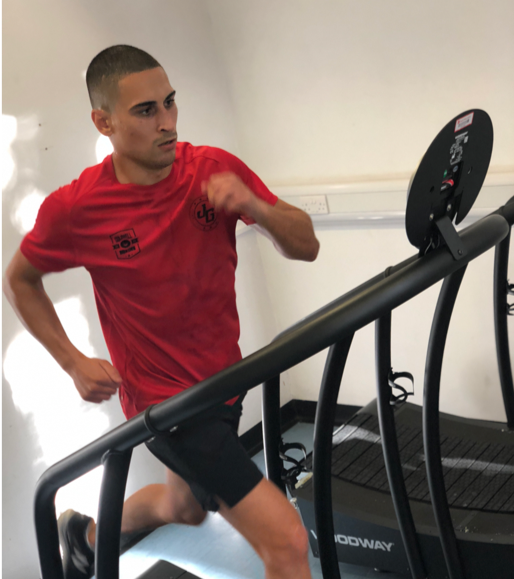
What are the physiological demands of Boxing?
The longest potential duration for a professional boxing match is 47 min with 36 min that time considered active. At boxing’s most extreme, the world-record for the greatest number of punches thrown in a fight by a single boxer is 1848 over 10 rounds – that’s a strike rate of 1 punch a second for 30 min.
That might sound extreme but it’s not unusual to see strike rates of 150 punches per round either in domestic level competition too. For reference, the average number of punches per round is somewhere in the region of 60 (Compubox) – a strike rate of 1 every 3 seconds.
The pace of a fight is determined, in principle, by tactics. A boxer might want to start quickly and take the first 3 rounds before settling into the fight, or they might want to increase the intensity each round. They might even pace themselves within a round to ‘steal’ points by impressing judges in a specific way.
A well-known psychological concept called ‘serial positioning’ relates to memory recall. It describes two components of our recall bias – primary and recency effects – in other words, we remember the things we see first and last but we don’t recall middle events as well. With this in a mind a boxer might want to start a round fast and finish fast to have the greatest impact on judges perception and in some instances ‘steal’ the round.
Nevertheless, the pace of a fighter is limited firstly by the opponent but secondly the fitness of the boxer.
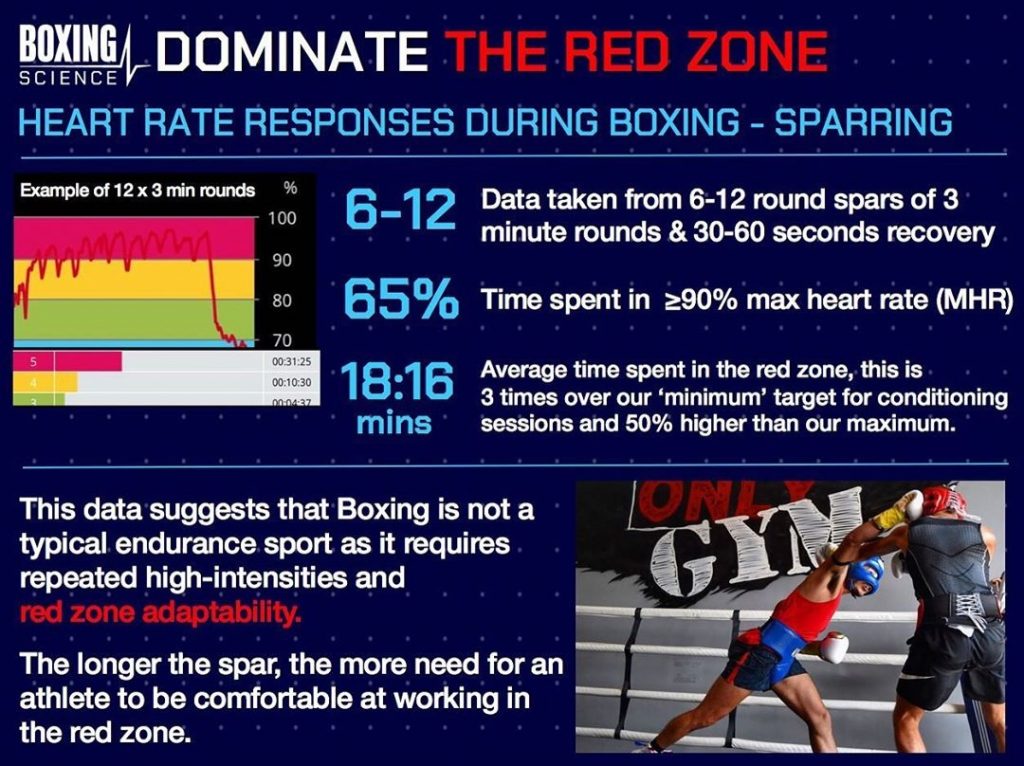
Boxing is a high-intensity intermittent-impact sport that forces you into the red zone (>90% Max Heart Rate) so boxers should look to develop the ability to perform at high intensities.
You know the feeling, your breathing is heavy and your heart is pumping hard and it feels ‘very hard’. It’s easy to make mistakes in this zone, thinking is harder, footwork slower and maybe your punch force is a little less.
These are all normal physiological responses, what we need to do is train the physiological mechanisms that are responsible for all these responses.
We want you to become red zone dominant. We want you to be able to work in the red zone with clarity, rapid footwork and forceful punches.
Fight intensity
Take a look at the graph below. The dotted lines represent performance (or fight) intensity. Notice that fighter A’s performance intensity is below the tip of their red zone but greater than the red zone for fighter B.
In this situation, the intensity of the fight is greater than what fighter B is capable of.

This means fighter B has to work very hard to match the intensity of fighter A and will likely have to work equally as hard when all they want to do is try and recovery, fatigue will occur very quickly for fighter B. In this situation we’d say fighter A is dictating the pace and rhythm and dominating the contest.
Physiological demands of boxing
- Boxing isn’t an endurance sport! It’s a sport of repeated high-intensities.
- Studies suggest that boxing is predominantly an aerobic sport (75 – 80%), therefore increasing an athletes aerobic capacity is a priority.
- The majority of time during sparring and competitive bouts is spent above 90% maximum heart rate, often referred to as ‘The Red Zone’.
- An athletes capability to perform repeated high-intensity activities is often a determining factor of performance.
With these important facts in place – we need to define our conditioning strategy.
Blood lactate profile
This simple test provides us with a lot of useful information. The test consists of 3 min running with a 1 min rest period. In that rest, we take a small fingertip blood sample and analyse it for lactate. Lactate is closely related to the level of acidosis and fatigue so that when lactate in the blood rises we can be confident the athlete is working harder to maintain speed. We increase the speed after each 3-minute stage until the athlete is working very hard.

On the figure, you’ll notice speed on the horizontal axis and blood lactate on the left and heart rate on the right vertical axes. The blue dots represent a blood lactate value taken after 3 min at each speed, the red dots are heart rate taken at the end of each 3 min stage. The most distinctive feature of the figure is the curve of the blue line after 15 kph. It rises very quickly because lactate has started to appear in greater concentrations within the athlete’s blood, telling us that the intensity of exercise is getting more difficult for our athlete.
Boxer Vs endurance athlete
A typical boxer has a blood lactate profile that looks very similar to an endurance athlete. Both are very good at running and controlling the intensity early on in the test. But, as we crank up the speed boxers, like endurance athletes find it increasingly difficult to deal with the accompanying cellular acidosis.
This is bad news for an athlete who needs to repeatedly produce high force and control acidosis. The first problem is that the absolute intensity or force probably won’t be as great as it could be, the 2nd problem is that even if they did go deep into the red zone they’d find it very hard to recover quickly enough from it, and thirdly without the capability to produce high-force and recover from it, there’s not potential to able to repeat high-force actions which is a crucial aspect of combat sports performance.
We train our athletes to make sure they don’t look like endurance athletes so that they can produce, recover and repeat high-intensity actions without losing control.
After 1000’s of sessions, we have over 100 different conditioning sessions in our locker that sit across our conditioning continuum
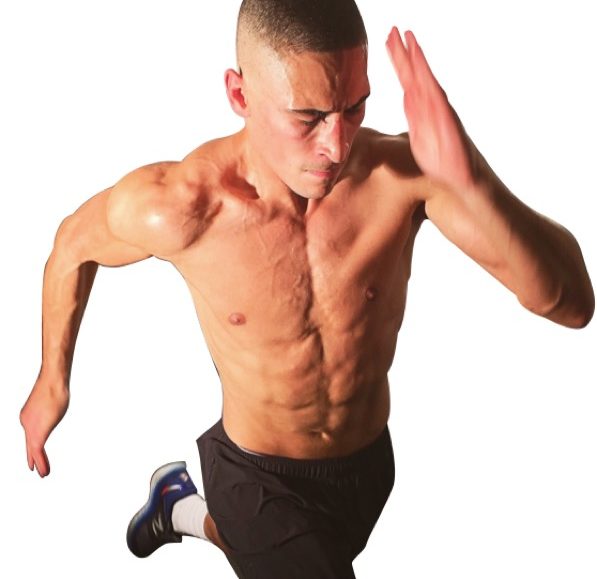
Our Conditioning Goal: Improve the ability to produce, repeat and endure high-intensity activities
We develop this by cycling through a range of conditioning
methods targeting different physiological adaptations.
After 1000’s of sessions, we have over 100 different conditioning sessions in
our locker that sit across our conditioning continuum.
It would take a full book to explain every single run, maybe one day we’ll have
the luxury of producing one but for now, to keep it short and sweet, we’ll
introduce our THREE main conditioning sessions.

High-intensity interval training
Aerobic capacity sets the upper limit of boxing performance. The more oxygen you can deliver to your muscles to fuel energy production the better you’ll be able to perform repeated high-intensity actions.
The amount of oxygen you can deliver to your muscles is limited by your heart. If you can improve the amount of blood that is pumped out of your heart and the network of arteries and veins you’ll be able to fuel high-intensity performance.
So the target in our 4 min interval sessions is to spend an optimal amount of time in the red zone, close to the maximum pumping capacity of the heart and oxidative capacity of the muscles. By carefully implementing this training strategy over a training camp you’ll be creating a bigger engine to power your performance and recover between rounds.
Muscle buffer training
When you perform high-intensity actions you also create an acidic cellular environment that you might know as the burn. This increase in acidity makes it hard to generate high forces because our neuromuscular system doesn’t work as well under these conditions.
Our body has a defence against this and they’re called muscle buffers. Their job is to ‘mop’ up the cellular by-products of high-intensity performance and help maintain the pH of the muscle cell.
Our 2 min interval training sessions place the muscle under high-moderate acidosis which stimulates the production of muscle buffers and improves the ability to produce high-forces for longer without completely gassing out because of fatigue
Sprint interval training
Delivering more oxygen to the muscle to help improve performance using 4 min intervals is effective but it takes weeks because of the physiological structures that need to adapt. But sometimes we need a rapid change in fitness to kick-start our training and this what 30 s max effort sprints give us.
When oxygen is extracted from the blood to the muscle cell it needs to be utilised by oxidative enzymes. The more oxidative enzymes we have and the better they function provides us with a better chance to produce energy for high-intensity performance.
30 s max effort sprints provide a strong signal for rapid changes in oxidative enzyme capacity and function as well as having beneficial effects on neuromuscular force generation, coordination at high speed and mental toughness. If you need a serious kick at the start of camp these sessions provide you with a kick like no other.
30 s max effort sprints? What are they?
Quite simply these are 100% sprint efforts for 30 s, repeated a minimum of 4 times, with 3 minutes recovery between each 30 s effort.
The key to the success of these intervals is in the initial attack because it the first 5, 10 and 15 s of the interval all play a role in how you’ll adapt to this session.
The last 15 s is all about focusing on your technique and trying to maintain relaxed in the face of extreme fatigue and pain.
What do they do?
The key to the success of this session is in the first half of each rep. We want you to attack the intervals as hard as you can.
This strategy has mechanical and physiological benefits. When you’re fresh(er) at the start of each rep you can run faster, and running fast requires you to recruit a lot of muscle and coordinate its movement in time and space to create speed. In other words your training your body to rapidly produce high force.
By running faster you stimulate calcium release, deplete high-energy sources within the muscle, produce a lot of acidosis and in turn metabolites and you also release a lot of adrenaline. All of these factors interact and combine to send very strong adaptive signals for your muscles to improve their ability to utilise oxygen within the cell.
These sessions are so effective that it’s possible to observe clear adaptations within 6 to 9 sessions, making this approach to training ideal for the start of camp.
Why are they great for boxers and combat athletes?
Boxing is a sport that requires repeated high-intensity actions that are dependent upon the aerobic energy system.
30 s max effort sprints help you train your ability to rapidly produce and sustain high-forces that are important to the success of combat sports performance.
And because your performance is dependent on your aerobic energy system, and although these look like anaerobic efforts, they have a strong aerobic demand, especially as the session continues – and its this aerobic demand that helps you to improve the way your cells utilise oxygen – therefore helping aerobic performance capability.
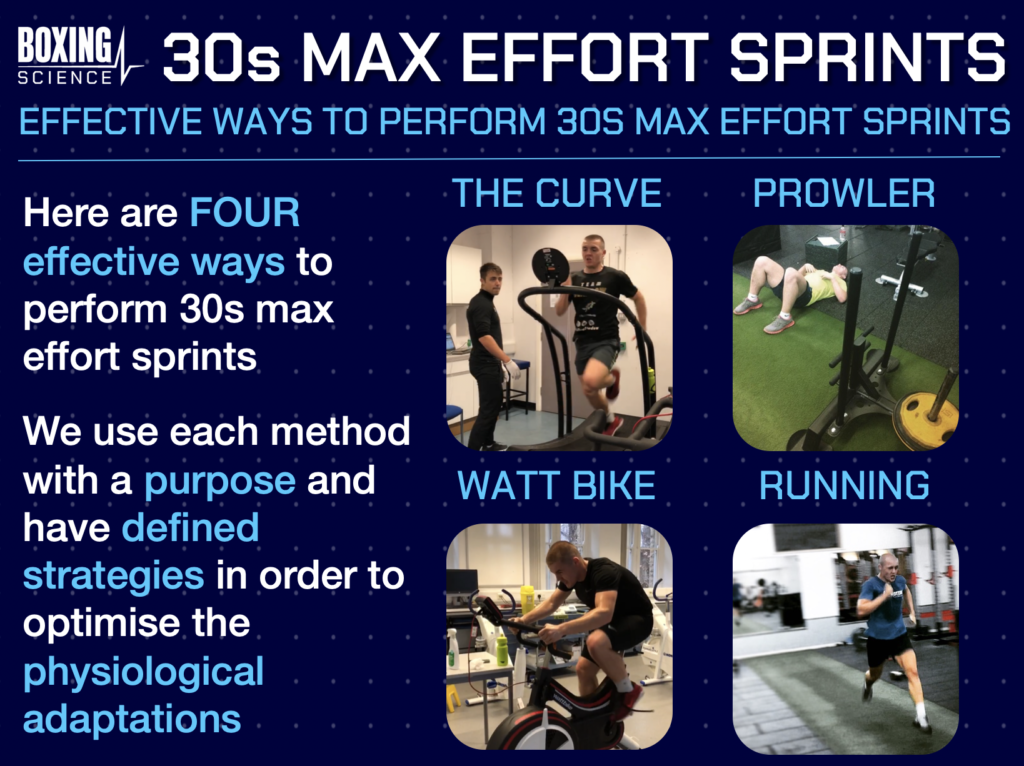
Do they actually work? Case study of Jordan Gill
Several scientific studies have demonstrated the effectiveness of 30 s sprint interval training and at boxing science, we have collected over 10,000 data points from our 30 s maximum effort sprints.
One of our favourite ways to share information is through case studies. So to demonstrate the effectiveness of 30s max effort sprints, we’ll analyse the progress of featherweight champion Jordan Gill.
The importance of monitoring performance is exemplified in the figure below.
The graphs have various key elements to them; 1) the speed of the interval displayed on the vertical axis; 2) the blue dots that represent speed recorded at 7, 17 and 27 s for each set (1 – 4); 3) data collected in 2016, 2017 and 2018 which describes the progression Jordan made during these calendar years and 4) the shape of the line that join the dots together.
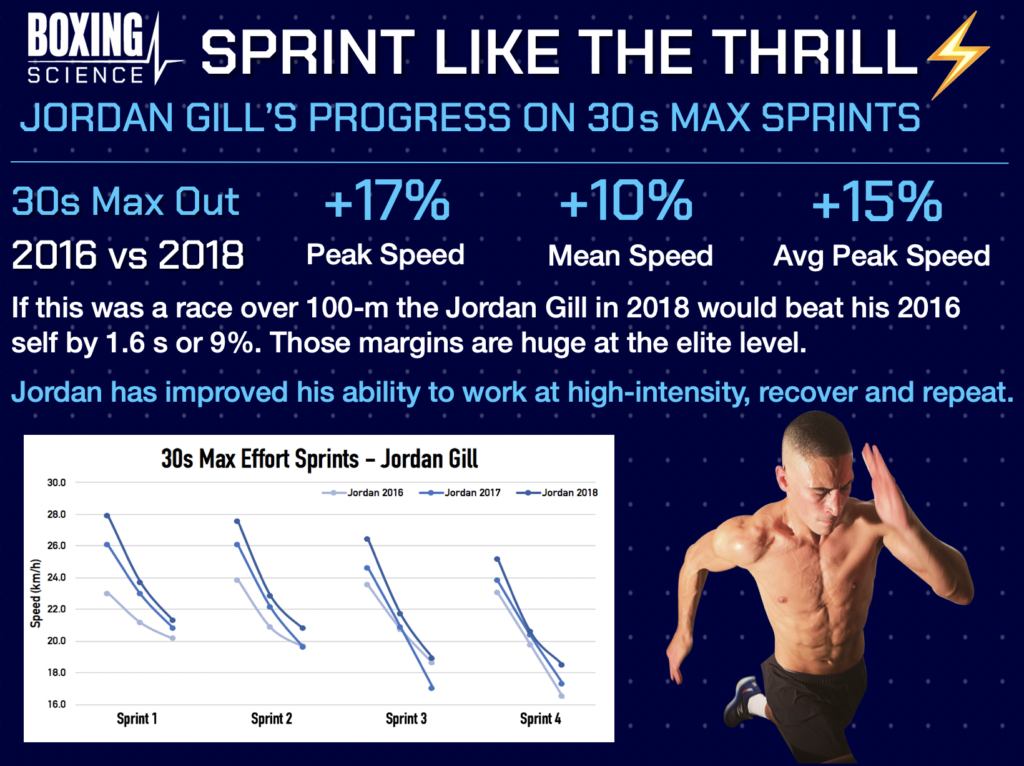
Peak Speed
In 2016 Jordan’s peak speed in the first and second intervals is 23 and 24 km/h. In 2018 These values increased to 28 km/h. He is now able to produce more energy, recruit higher force motor units and co-ordinate his muscles to achieve faster speeds.
Final Rep
As Jordan progresses through the session he’s able to consistently maintain better speeds throughout and in the final rep maintains his speed far better in 2018 compared to 2016.
The decline in speed in 2016 is 6.5 km/h and is comparable in 2018 but his speeds are much higher. If this was a race over 100-m the Jordan Gill in 2018 would beat his 2016 self by 1.6 s or 9%. Those margins are huge at the elite level.
Curve profile
You’ll also notice that in 2016 the slope of his speed decline is steep whereas in 2018 there’s more of a tick mark in the final 10 s.
This demonstrates he’s able to maintain his speed more consistently across the reps in the face of mounting fatigue.
I’ve improved improved my ability to work at high-intensity, recover and go again.
Jordan Gill – WBA International Featherweight Champion
High-intensity Interval Training
An athlete is in the red-zone when they are working above 90% maximum heart rate.
Our programmes are designed so that boxers can dominate the red zone by performing at high-intensities, recover and repeat.
Boxers should aim to become red zone dominant. A boxer should be able to work in the red zone with clarity, rapid footwork and forceful punches.
How do I work in the Red Zone?
We get our athletes working in the red zone using High-Intensity Interval Training (HIIT)- this consists of 4 to 8 min efforts at 90% maximum heart rate or 9/10 effort. Rest half of the exercise time. Repeat 4 to 6 times.
Aim: spend as much time >90% maximum heart rate as possible.
Why? Research has shown this type of training places strain on the heart and the cardiovascular system, so the heart can deliver more blood carrying oxygen to the muscle.
The video below shows a great example of Gavin McDonnell performing a HIIT session, dominating the red-zone.
If a boxer can’t run, another suitable alternative is to perform HIIT on an indoor bike. Ideally you’d record average power during each interval, but some bikes don’t have power meters so the next best thing is speed or the ‘level’ of intensity. Try to choose the same bike each time for your intervals (same for treadmills too) as gym based treadmills can deviate between each other despite being the same model.
Another alternative is an indoor rower – usually we wouldn’t recommend these for Sprint Interval Training (SIT), but because the technical and force demands of rowing are less in HIIT they do enable athletes to reach the red zone. Similar to the bike, record the average power for each of set. For all these intervals you’ll need to pay close attention to heart rate. Speed or Power may need to be modified to ensure enough time is spent in the red zone!
Our tips for working in the red zone
Before starting HIIT, we need to get a true or estimated value for maximum heart rate. There are several predictions – all with flaws, the easiest way to estimate it is to use 220 – age. For example;
200 – 25 = 195. Maximum heart rate is 195 bpm.
90% of maximum heart rate = 195*0.9 = 176 bpm.
The athletes red zone target is therefore to exceed 176 bpm.
Another way to calculate maximum heart rate is to undertake a ramp assessment. Put the treadmill gradient at 1%, set the speed to 10 kph. Every minute increase the treadmill speed by 1 kph until exhaustion. During this test, maximum heart rate should be reached.
Most problems with red zone running arise from not knowing maximum heart rate, the methods above will help you calculate that.
If you know the red zone heart rate value, but still struggle to get there, it’s probably because of 3 things:
- The warm-up isn’t sufficient enough to raise body temperature
- The first interval is probably too fast
- A combination of the above
Solutions
Extend the Warm-Up: Within the warm-up, starting slowly for the first 3 minutes, and raising the speed slowly for the next two can be effective.
The
warm-up should consist of working through the gears, one minute at a time. At 5
minutes, the speed should be challenging.
After 5 minutes, rest for 1 minute, and increase the speed again for 2 minutes,
taking the warm up to 8 minutes.
Then set the treadmill to the target starting speed and run 3 x 30 second intervals with 15 seconds recovery between. Rest for the remainder of the 10 min warm up before starting the session.
Build Up The Intensity
If the interval is too fast to start with, a significantly greater anaerobic contribution to the energy demands will be used, compared to what’s needed. An oxygen defecit will occur, and there will be an increase in cellular acidosis that will be difficult to get rid of.
This
will cause you/your athlete to run slower than you should after a couple
of minutes.
A lower speed = less oyxgen demand and less oxygen demand = less demand on
the cardiovascular system, including heart rate. This will prevent the red zone
from being reached.
Record as many variables as possible, to track progress and optimise sessions.
- Speed (km/h)
- Rating of Perceived Exertion (RPE) /10
- Average Heart Rate
Time spent in the Red Zone (>90% Max HR).
On the appropriate training session, attempt to spend the majority of the working time (example 4 minutes) in the red zone (90-100% Max Heart Rate).
FIND OUT HOW TO PERFORM HIIT FOR BOXING AND COMBAT SPORTS BY SIGNING UP TO OUR MEMBERSHIP

